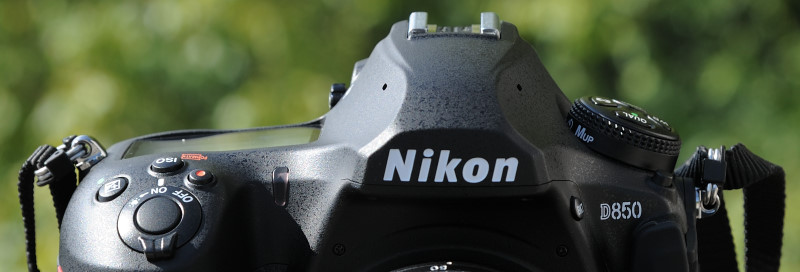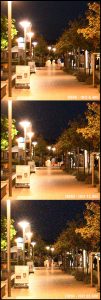D850 – first impressions
 Five years after announcing the D800 and three years following the modest upgrade D810 the long expected high-res successor got announced in the form of the D850.
Five years after announcing the D800 and three years following the modest upgrade D810 the long expected high-res successor got announced in the form of the D850.
The technical specifications are quickly summarized: 45,7 MP sensor, 7 without or 9 fps with battery grip MB-D18, AF module Multi-CAM 20k of the D5, including the dedicated AF processor that the D500 lacks, two memory slots with one UHS-II compliant SD and one XQD. All together a quite solid upgrade to the D810.
Body
The D850 feels almost identical to the D800/D810, the control layout matches exactly the D500. The most notable difference are the two somewhat irritating openings for the stereo microphone on top of the viewfinder prism housing. While introducing the D500 Nikon argued that the small pop-up flash was left out to achieve a better weather sealing. This seems a little bit strange now.
At least lead the omission of the flash to the inclusion of a bigger viewfinder. The difference is clearly visible compared to the D800 and helps with manual focusing.
The buttons on the left side can be illuminated (like D500), the tilting touchscreen provides higher resolution and enables touch operation for the settings menu, which speeds up the operation quite a bit.
The D850 grip rubber is different from D800/D810. Gone are the days of soft rubber grips, which have been part of Nikon’s body designs since the D200 of 2005. The D500 featured already a harder grip material, but this is a bit stiffer and looks almost like plastic covered with a soft finish. I hope, that this is just an impression and that it is not a kind of soft finish, otherwise we might see the return of sticky bodies (D70(s) owners will know what I am talking about).
One further rubber was removed at the bottom of the camera. The tripod socket is now surrounded by a hard plastic inlay with small indents. However, quick release plates with rubber top will find enough grip. Nevertheless it is sad to see the scratch resistant bottom cover disappear.
Next on the cancellation list is the bright AF support light. Not many people will be worried to see it disappear, especially given the very good autofocus performance.
As a big surprise comes the mechanically changed XQD slot. Up until now all XQD slots worked with a push-in/push-out mechanism. Owners of the D4 already complained about sticking XQD cards, obviously those reports made Nikon implement a traditional push-out lever, which is otherwise only used with Compact Flash cards. I still find myself pushing on the card, using a D4 and D500 in parallel this will be a real challenge for me to change habit only for the D850.
Battery grip MB-D18
Surprising is also the new battery grip MB-D18. Like in the days of D300 and D700, the grip increases the frame rate from 7 fps to 9 fps. Even more surprising is the fact that MB-D18 of D850 and MB-D17 of D500 are mostly identical. The only difference can be seen at the top plate, connecting to the camera. There are only minor differences in the shape of the top plate, even the electrical connector resides at the same location. Only the positioning of a fixation pin (that goes into a corresponding hole in the camera body) prevents the cross-wise usage of grips and camera.
Nikon could – and should – have been more generous to offer the same grip for both cameras like ten years ago with MB-D10 and D300/D700. Obviously the opportunity to grab more money was more important than customer service. In case that electrical contacts have the same configuration, we will see dual usage grips from 3rd parties soon.
Similar to the camera body, the bottom of the MB-D18 only offers a hard plastic inlay instead of the glued on rubber, which was still provided with the MB-D17.
Autofocus
Compared to the D500, autofocus performance is mostly identical on the D850. Multi-CAM 20k operates fast and precise; tracking of moving objects is clearly better compared to Multi-CAM 3500. Even the focus indicator works better for manual focus with less error margin to left and right. For owners of a D800/D810 autofocus performance will be one of the biggest improvements, which might be one of the key arguments to upgrade.
Image Quality
D800 and D810 already offer a very good image quality. The increase of resolution by 10 MP is almost not noticeable and should be no reason to upgrade from a 36 MP camera. More important are dynamic range, high ISO performance and general color rendering. Dynamic range is almost equal to D800/D810, with measurable slight disadvantage between ISO 100 and 400 and slight advantage above. The corresponding measurements can be seen on the website „Photons to Photos“ from William J. Claff. In real world shooting, no difference can be seen.
The increase in resolution takes its toll regarding high ISO performance, at least when you are expecting a boost compared to the previous generation. In direct comparison and at 100% magnification, no major difference can be seen between D800 and D850. At ISO 6.400 the D850 is slightly worse than the D800 and ISO 12.800 can only be used in emergencies. ISO 25.600 would have been – based on the performance – part of the extended “HI”-range in former times.
For ISO evaluation I compared RAW files with completely de-activated noise reduction. Many people do see improved ISO performance, this can only be based on activated NR and/or JPEG output.
I used the D800 with a maximum ISO of 3.200 before, which will be the same for the D850. Given the 10 MP increase in resolution, this is clearly an evolution. Nevertheless, the times of big improvements are over.
One aspect, that I would like to highlight, is the rendering of color. From my point of view, the overall image rendering has been improved compared to the D800. Nikon tweaked the color palette slightly. It reminds me a bit of D2x and D3x. Those two were also no high-ISO wonders.
New included are two different modes for auto white balance. “A –sun” tries to align the white balance with the natural light situation (in doubt a bit warmer), whereas the “A – Auto” tries to adjust to a neutral, rather cool white point. The latter corresponds to the former automatic white balance and works more secure than before.
Even the modest increase of 10 MP reveals slight focus errors faster, a bit more care has to be taken when working with a 45,7 MP sensor. To my surprise the increased resolution does not further lower the usable aperture range, before softening effects of diffraction show up. First tests indicate even the opposite. With the D800 diffraction was visible at f/11, while the D850 holds detail quite well when comparing f/8 with F/11. Maybe the new BSI (Back Side Illuminated) sensor technology comes into play here.
Auto ISO
The increased resolution also shows effects of camera shake, which in turn affects the Auto-ISO function. If you let the camera decide the shutter speed based on focal length, the middle setting still sticks to the “1/focal length” rule, which is in my opinion not sufficient any more. The next setting towards shorter times directly cuts the shutter speed in half, which increases the ISO unnecessary in most situations. Nikon should allow for finer intervals or increase the setting in the middle by 10 to 20% offset.
Silent exposure in Live View mode
One of the most important new features of the D850 is silent exposure. Nikon utilizes an electronic shutter for the first time and makes it possible to take pictures without moving shutter or mirror at all.
Two modes are available: SL1 and SL2. SL1 mode takes pictures in full resolution with a maximum speed of 6 frames per second. In SL2 mode a DX crop with reduced resolution of 3600×2400 (8,6 MP) is recorded in JPEG, but the speed is increased to 30 frames per second when shooting in Ch drive for a maximum of 3 seconds, but always without focus tracking.
The so called “shutter counter”, hidden in the metadata of every image file, is increased by one for every picture taken in silent shooting mode, despite the fact that mirror and shutter are not moved for those pictures at all. The counter is therefore now reduced to being a simple image counter and can no longer be used to determine physical wear of the camera when buying used.
Nikon added two separate counters for physical shutter movements and slient mode exposures in the meta data. Those counters can be read out using updated shutter count programs, one of the first ones can be downloaded here: http://blog.naver.com/dodge46/221137770747
Live View autofocus is not faster than before, but a bit more precise. For Video 4k resolution (without image area crop) is now available. However, I will not comment on video performance since I am only taking stills with my DSLRs.
Conclusion
The D850 is an excellent studio and landscape camera, like D800 and D810 before. It covers now additional areas of photography with more than solid performance, without becoming the top choice in them.
For many people price will be the deciding factor between D500 or D850, especially if nature, wildlife and sports are the main subject. In this case the smaller brother might be the more economical choice.
Professional photo journalists shooting sport, events and politics will still pick a D4/D5 above everything else. D500 and D850 do not even come close to the low light performance of the single digit D-series – not even when downsizing D850 files.
For owners of D800/D810 the new autofocus module in itself may very well be the reason to upgrade, combined with the new features like silent mode exposure and tilting monitor on the back. The increased resolution of approximately 10 MP or the image quality overall should not be a reason to upgrade. Differences are too small for the expense.
Putting all things together, the D850 is a very well rounded and refined camera. It is an instant classic in the Nikon lineup, like the D700 was at the end of the last decade.



